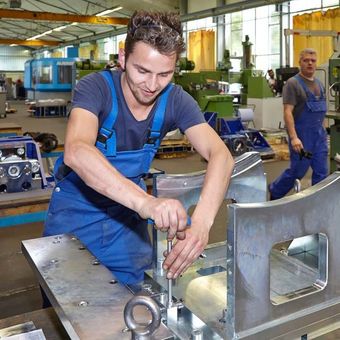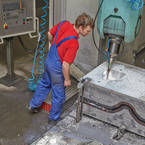What is extrusion blow molding?
Extrusion blow molding is an industrial process, in which blown containers made of plastic are made. Thermoplastic resin, a type of plastic which can be deformed in a certain temperature range is used as a starting material. In extrusion blow molding a malleable plastic blank is pressed with air pressure against the walls of a negative mold. The hollow products which can be manufactured using this process include for example, Canister, fuel tanks, air ducts, ampoules and children's toys. Kremann and Esser are specialized in developing the negative molds as well as the associated devices for this procedure.

The manufacturing process of extrusion blow molding
In the first step of the extrusion blowing process the raw material, synthetic granulate is introduced into the so‑called extruder. At this stage it is important to ensure the correct plastic mixture, because this influences the properties of the product to be manufactured. With years of experience Kremann and Esser supports its customers finding the correct plastic mixture.
Within the extruder, the synthetic granules are heated and compressed. There is a worm shaft within the extruder for that purpose, which also transports the heated material to a nozzle. Through the nozzle the material is squeezed vertically outside, producing a tubular mold. This process is called extrusion. The name of the extrusion blow molding process has its origin in this very first stage.

When the plastic tube, also called parison, has the right length, the cooled metal mold closes and presses the lower end of the tube together. The parison is thus sealed at one end. At the top end usually a knife separates the parison from the extruder. The cooled metal mold consists of two parts, which have the negative shape of the produced product on their inside. The toolmaker Kremann and Esser is an expert when it comes to the development of blow molds for extrusion blow‑molding. This is the core competence of the company that stands for highest precision and quality.
After the metal mold is closed, a spike is inserted into the top of the parison through which compressed air is then pressed into the parison. The parison is inflated into the shape of the hollow container, bottle or part. In this process the spike also forms the upper opening of the plastic product. After that the hollow plastic product still needs to cool and can then be released from the mold. Leftover plastic residues are separated from the product and added to the extruder again. Kremann and Esser is particularly known to develop tools that ensure fast cycle times and high material savings.
